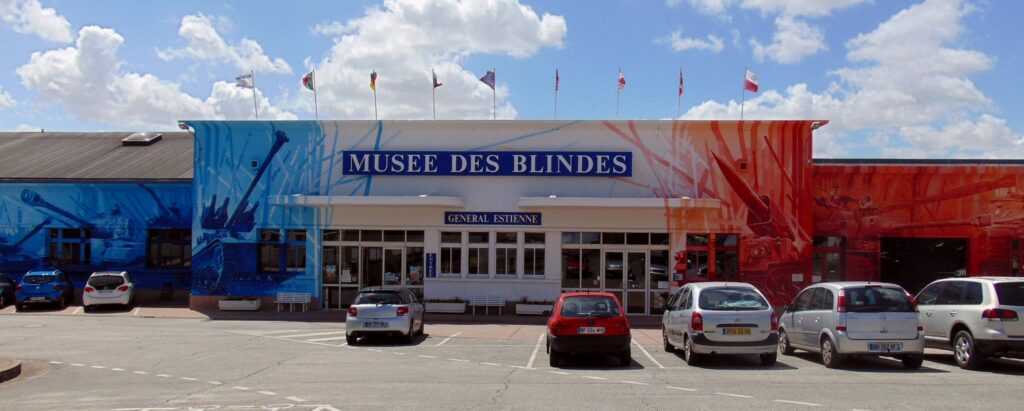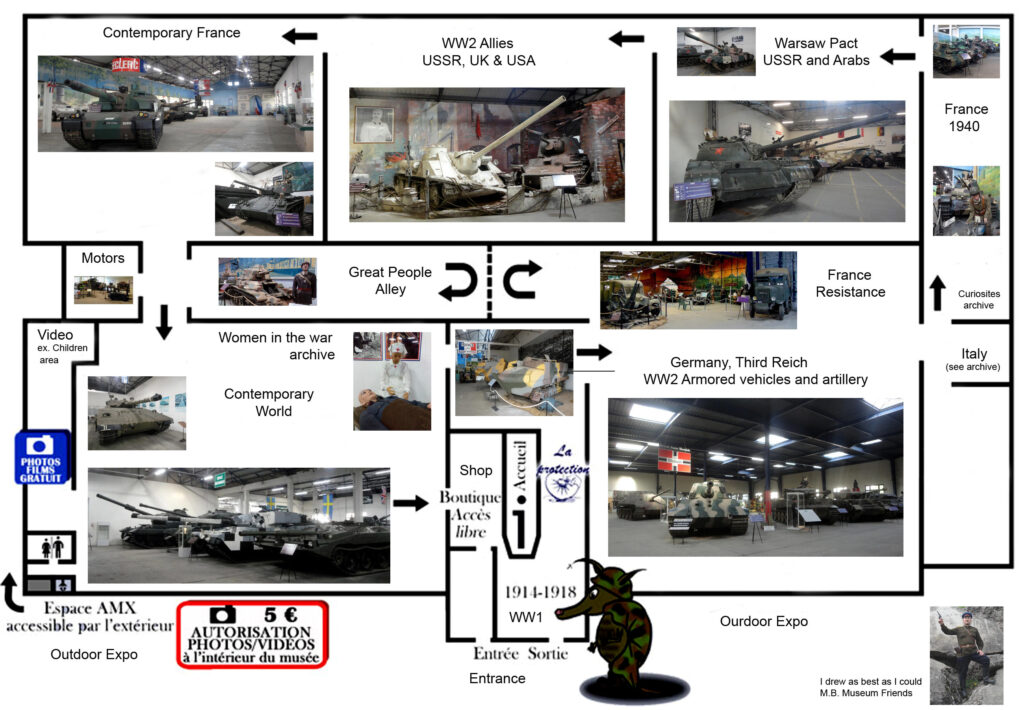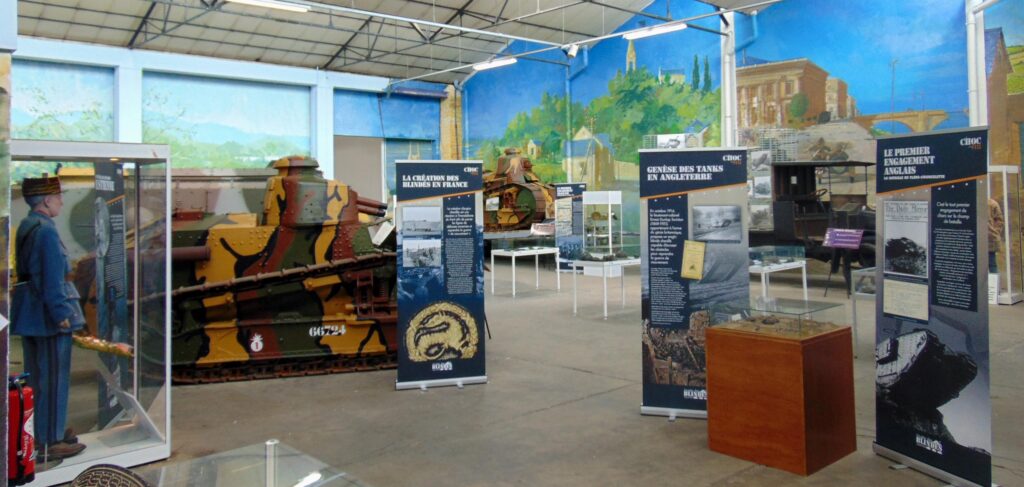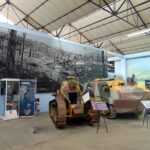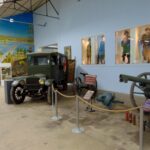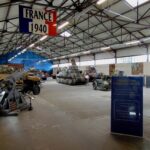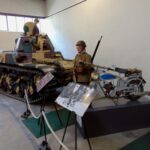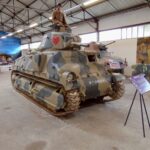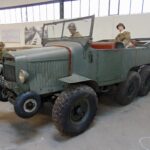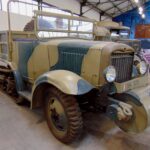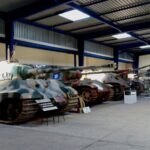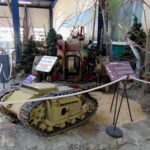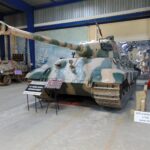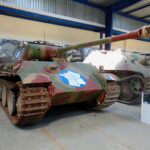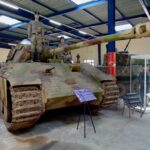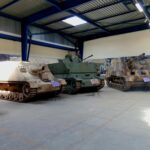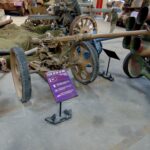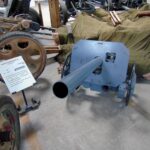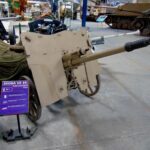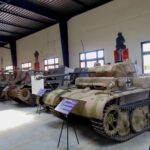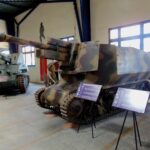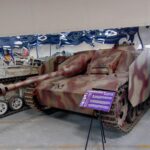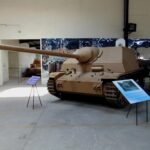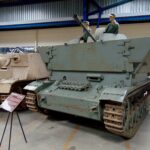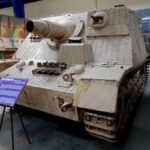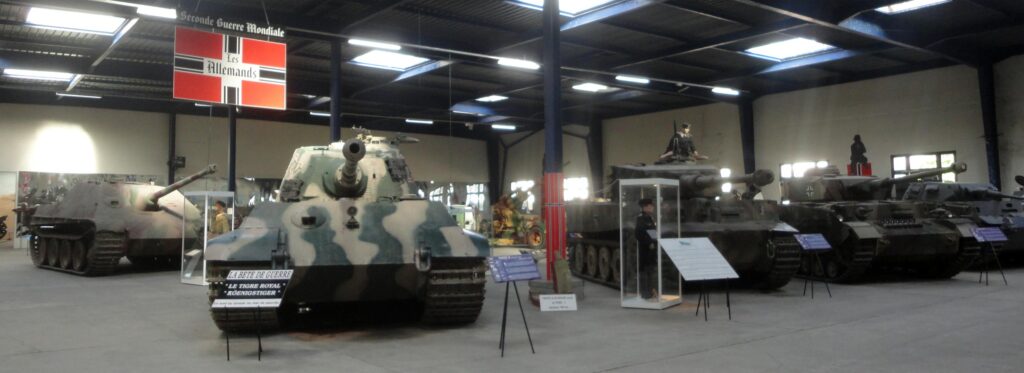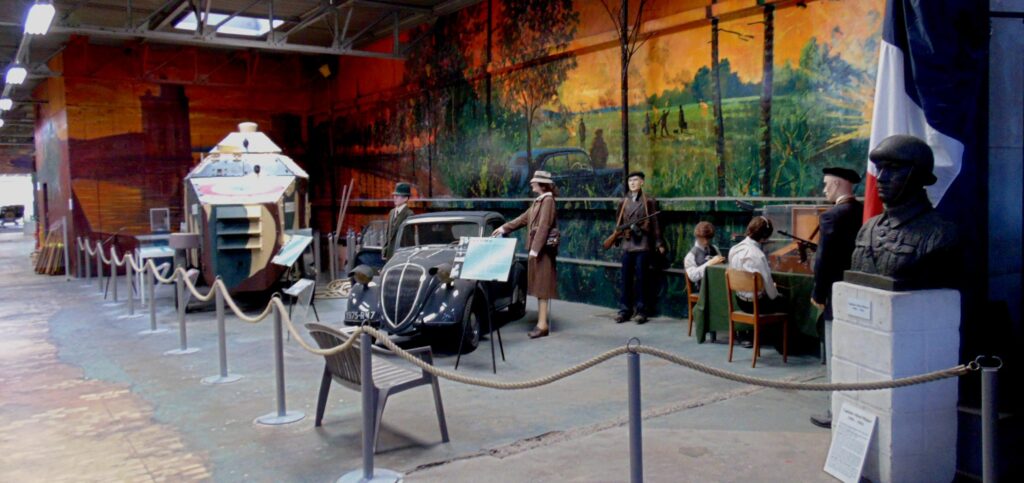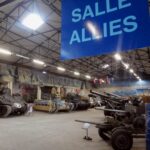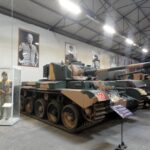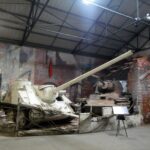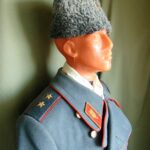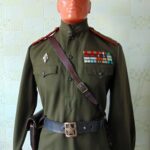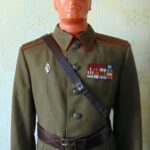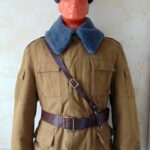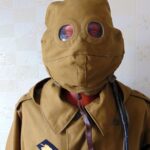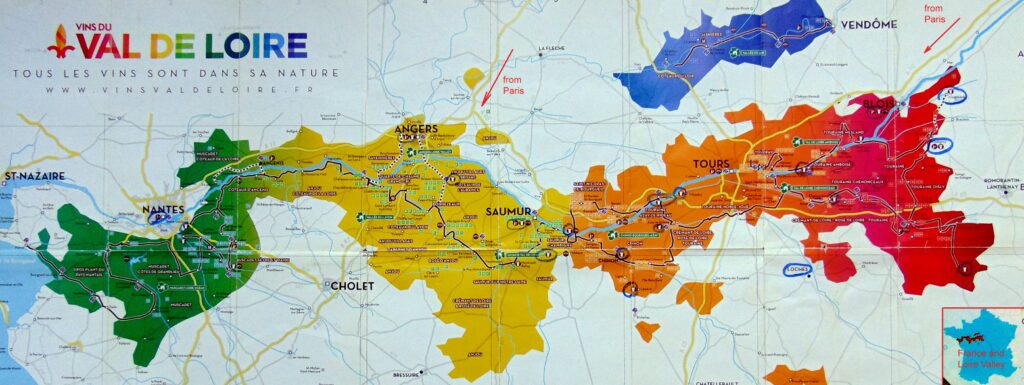The Tank Museum in Saumur (French: Le Musée des Blindés) is one of the world’s leading museums of the armored weapons and equipment, and is also included in the best military history museums in France. The museum is located in the historical region – the Loire Valley region, where castles and various ancient buildings are located, which in themselves are the sights of France.
The brief history of the tank museum in Saumur. The Loire, the river and the valley have a special place in the history of France. A natural fortified area, behind which the French army retreated and the area known to the whole world as the “Loire Valley” and “Loire Castles”. Well, where there are castles, there are kings. Where kings are, there are his guards, that is, the army. Where the army is, there is the entire infrastructure, including barracks, training schools, shooting ranges. Saumur is a city on the Loire, known since the 16th century as a center for horseback riding. It was here that the Cavalry School was founded. In the 20th century, after the First World War, cavalry units began to be replaced by “iron horses”. During the First World War, France was the world leader in the production of tanks and armored vehicles. In the 30s, Saumur also became a training center, where they began to train officers for tank troops, although the name (“Ecole de cavalerie”) has survived to this day.
The “traditions” of the creating almost all armored museums in the world are the same – the “collection” is collected for study. Driving performance studies. Study of individual elements. Studying how, from what distance and how it can be hit. So the “tank museum” in Kubinka was founded. Thus was founded the tank museum in Saumur. At the end of the Second World War in Saumur (Saumur), where the military unit was located, German tanks were collected, which remained on the battlefields. After restoration and repair, they were studied by French military engineers. These machines laid the foundation for the “collection”, which appeared thanks to the perseverance and enthusiasm of Colonel Aubry.
Tank Museum: In 1965, the French Ministry of Defense created the “Armored Vehicle Documentation Center” (Centre de Documentation des Engins Blindes – CDEB) in Saumur, which is considered the founding day of the tank museum in Saumur. Now the museum has more than 850 vehicles and armored vehicles, a third of them are on the move. 200 exhibits make up the permanent exhibition. The museum includes a team of specialists and a technical infrastructure that allows you to successfully carry out any repair and restoration work with armored vehicles.
Like in the USSR at Kubinka testing area, in addition to captured German tanks, the collection was replenished with vehicles removed from service with the French army, armored vehicles of the allies in the anti-Hitler coalition (USA-Britain), gifts from weapons manufacturers, as well as through exchange with other museums. There were other ways: at least a pair of Soviet T-54s and one PT-76 came to the museum from Iraq, captured after the first Gulf War. And “Shilka” got into the collection from the army of the former GDR.
The management of the museum, based on auto-armored vehicles, makes whole corners of “living history”, with mannequins and special expositions. There is also a whole corner of the “Battle of Stalingrad” with a rare Soviet heavy tank KV-1. True, the tank has its own special history, and the signs in the exposition are more reminiscent of the battle in Hungary or the Liberation of Yugoslavia. In the center is a portrait of Stalin.
The museum collection is constantly updated. Every year, Saumur hosts Carousel – a demonstration of old armored vehicles in action at the training ground of the Cavalry School. The current exhibits of the museum regularly take part in historical holidays and filming.
Restoration hangars are large and spacious, which makes it possible to work on many exhibits at the same time. In addition to the museum staff, 42 volunteers are involved in the restoration of equipment (for 2016). At the moment, work is underway on equipment, including tanks, cars, self-propelled guns of various historical periods and countries. Among them there are also unique samples.
Travel Guide and the map with the location of the halls:
Description of where everything is located, the order of the tour. The collection of the tank museum is located in the following halls and consists of the following expositions:
- Guide to museum collections and the halls
The First World War and the rarest tanks of the First World.
The collection of the First World War armored vehicles in the Saumur Tank Museum is really the largest in the world and will surprise you with the unusual monsters such as Schneider CA 1 and Saint-Chamond. Russian unsuccessful project of a giant tricycle with a turret presented by a scale model. Be prepared to take the time to check them out, which has the ability to look inside and go around all sides. The legendary Renault FT-17 tank is presented in the various modifications of the weapons, which has already been appreciated by the experts in all countries of the world. The Museum Friends Association has now greatly expanded this exhibition, occupying a large hall and a section in showcases of the artifacts – the uniforms, the awards, the flags, the documents and the photographs. The restoration hangars also have the rare AV equipment, which, as soon as it is ready, will be approached in the halls or on the open areas in motion. We give a detailed description and photo gallery of the modern and archival views of the section inside our Guide to the museum, as well as in the “Restoration of armored vehicles” section.
- World War 1 tanks
- Trucks, uniforms
- Artillery, small arms
– Battle of the Somme (Somme) first use of tanks in work
– Battle of Cambrai, a large tank battle, the new era
– legendary tank Renault FT-17 and the Victory Parade in Paris
Paris. Victory Parade in France, a column of French tanks of the First World War Renault FT-17 passes through Paris, along the Champs Elysees near the Arc de Triomphe. July 14, 1919. These French tanks are the first tanks in the usual layout, when the rotating turret is on top, and not like in the English “rhombuses” on the side. Tanks of this model participated in the First World War, as well as in the civil war on the territory of Russia, both in the European part and in the Far East.
The Second World War battles vehicles and weapons
The Second World War in the museum is presented in several important thematic sections and occupies several large halls:
– “Heroic Defense of France” 1940 hall
– Nazi Germany, Third Reich: tanks and self-propelled guns, artillery etc.
– Resistance movement. “Fighting France” World War II. Partisans, the underground.
– Italy:”Fascist – an ally of Germany and post-war
– Armies of the “allies” of the Second World War, where there is a section of the USSR.
Examining the French automobile and the armored vehicles, as well as rare modifications of the German AV, we can confidently say that the collection of the Second World War period in the museum is the unique and one of the five largest in the world. This was confirmed by the leading Soviet experts from the Kubinka training ground. All world collections of the armored vehicles are different, complement each other and have the national peculiarities. The Saumur AV collection will definitely surprise you by the many exhibits from the 1940 early period of the Second World War, as well as by the Allied D-Day landings in Normandy and the liberation of France.
- Battle for France 1940
- French vehicles
- 1940 Battle of France hall
- AV carrier
- Carrier
- tractor
The photographs show that France, being the world leader in the development of automobiles*, produced many unusual design solutions for the army, presented in the museum exhibition. Tourists from the USA have always loved the unusual cars (national tradition!) and will spend a lot of time to explore this section.
Each exhibit of Nazi Germany is a rare surviving example with its own unique history. The Saumur Third Reich collection includes all the classics AV from the defense of France in 1940 to the Allied landings in Normandy on D-Day and the Battle of the Bulge. Note that the “Royal” Tiger B is the only one in the world that is in working condition and can surprise museum guests on the certain holidays. There are also only a few of the small series “Tiger” Pz VI in the world, but this one in Saumur has an unusual history. The exposition also presents the unique and unusual vehicles based on self-propelled guns and the tank chassis. Note that in addition to tanks and self-propelled guns, the exposition presents a large collection of German artillery. In addition also to the “steel and armor”, the hall displays an excellent collection of the original tank and motorized infantry WW2 uniforms and insignias. The section is constantly updated with new exhibits.
- WW2 German tanks
- First German tanks
- Rare WW2 self-propelled unit (Samur tank museum)
It is believed that the largest collection of the WW2 Soviet tanks is located in Kubinka, where they were tested and stored. But Kubinka does not have the legendary Soviet heavy tank KV-1 (Kliment Voroshilov**) presented in Saumur. Almost all of these tanks were destroyed by the German aircraft and artillery at the beginning of the war. One surviving KV-1 was taken out of the river after the battle for Leningrad and is in very poor condition. Another surviving example after the war was used to train the cadets, is now in the Army Museum Moscow. Its undercarriage has been replaced and has late the rollers and the tracks. The KV-1 presented in the Saumur Museum has an original chassis and an even more the amazing history of the tank. The “ordinary” Soviet tank T-34 (76,2 mm) is also considered very rare, not to be confused with the T-34-85. Soviet medium T-34s were involved in the famous WW2 battles for Moscow, Stalingrad and Kursk, but almost all were destroyed by the end of the war. Since 1944, the USSR began to produce more powerful T-34-85 tanks, which are on all monuments around the world. Our team is a member of the Association of Museum Friends and donated to the Museum a big collection of Soviet tank crew uniforms, which are gradually exhibited in the hall following the example of the German one. Of particular interest is the uniform items supplied to the USSR through Lend-Lease along with armored vehicles, aircraft and food. This uniform has an unusual color, and on the buttons is the inscription “Made in the USA”. Rare and unusual are cartridge pouches, typical of the Red Army design, but made of blue denim. The opening of the “Second Front”, the landing of the allies on D-Day in Normandy is presented in the museum with samples of armored vehicles with their own history, as well as a large and beautiful exposition on a long wall.
- WW2 allies: UK, USA, USSR
- British and American vehicles
- Soviet rare heavy KV-1
“Cold War” and “Fighting France”
– Post-war France, overview and exposition of the museum
– Post-war French tank AMX-13
– “Fighting France” – wars in Indochina, local conflicts
– Armored vehicles of the USSR and the countries of the “Warsaw Pact”, “Arab brothers”
– Hall of engines (tank engines) and training simulators
We call all the wars in Indochina, Africa and the Middle East the “Cold war and local conflicts”. This is not only the history of France and its former colonies, it is a real world history with the participation of all powerful countries: the USA, Great Britain and, of course, the USSR. The Soviets constantly helped with military equipment and specialists to everyone who fought against France and the “damned capitalists.” As a result, Saumur received a large collection of the Soviet armored vehicles as the trophies from all local wars and conflicts. The uniqueness of this collection is that it was used in the service of the warring Arab countries and has an interesting history of each exhibit. There are also exhibits from the former socialist countries of the “Warsaw Pact”, which have now become members of NATO. Our team also donated to the museum a large collection of the uniforms of Soviet tank crew and motorized infantry for the different periods of the history and events. For tourists from all over the world, such events as the Soviet occupation in Hungary in 1956, the suppression of the Prague Spring in 1968 by the tanks and of course Afghanistan are of interest. Only a small part of the donated collection is still on display, the rest is waiting for the future exhibitions. The museum will be very grateful to everyone who donates mannequins to expand the Cold War exposition.
Cold War Soviet uniforms and insignias
A collection of Soviet uniforms donated by Mikhail Blinov (Tour Guide author) to the tank museum. Partly on display, partly in reserve fund.
- Commander of tropospheric (alternative) communications in the event of a nuclear war, lieutenant general Shitov, 80-s (Saumur tank museum)
- Soviet army uniform, AV marshal M1959 (Saumur tank museum)
- Tank unit major-general field uniform M1969 (Saumur museum)
- New experimental “Afghanistan” field winter uniform, 1980s (Saumur tank museum)
- Driver’s mask against the wind over a tank helmet (Saumur museum)
“Great people” – famous military leaders, generals, marshals
Personal belongings, the uniforms, the awards of the National Heroes of France, the famous commanders and even the President of France Charles de Gaulle. Well-known commanders of the armies of all else warring countries, including Germany and the USSR, are also represented. The Soviets are represented by Georgy Zhukov, officially titled “Marshal of the Victory”, unofficially “The Butcher” for his outnumbered attack tactics. After the Second World War, Zhukov fell into disgrace with Stalin for too much personal “trophies”, and with Khrushchev for the trying to take power into his own hands. Each outstanding personality has its own type of car or tank, which makes this hall doubly interesting.
– “Gallery of Military Glory”. Women in the war…
“Modern World” – tanks, armored vehicles of NATO and other armies of the world during the Cold War period and are in service now.
Would you like to look at the traditional armored vehicles of all countries of the world, including NATO and even Israel? Then reserve enough of time to visit this large room. Heavy monsters of Great Britain left over from the Cold War, the armored vehicles of the Bundeswehr and even the legendary Israeli tank Merkava (chariot). According to the old military traditions, in connection with the latest political events in Ukraine, the collection of this hall is likely to be replenished with new exhibits. Already in 2014, the Museum received the samples of the uniforms and awards from this conflict, which was just beginning…
Local wars and military conflicts, peacekeeping operations:
– Indochina and the Vietnam War
– Post-war wars and operations of France in Africa, list
– War in Angola (1975-2002)
– Republic of the Congo. History and armored vehicles
– Riot in Katanga (Congo) in 1977
– Congo (Zaire). Second Battle of Shaba in 1978 and Panhard armored cars
The museum has more than 850 AV’s, a third of them are in the work condition. There are more than 200 exhibits in the permanent exhibition. The museum has a team of specialists and technical infrastructure to successfully carry out any repair and restoration work with armored vehicles.
Restoration of the old military equipment and weapons
The Saumur tank museum has several hangars where military equipment is restored and stored – tanks, cars, including those from the period of the Second World War. The number of exhibits in these hangars is commensurate with the amount of equipment in the permanent exhibition. Some tanks, armored personnel carriers and cars are shown on certain dates in motion, on the go. Restoration of equipment is carried out by museum staff and volunteers – a team of volunteers (more than 40 people)
One of the halls is very large and spacious.
Museum opening hours:
January February March April. Monday-Friday 10am-5pm, Saturday-Sunday, Holidays 11am-6pm. May June: every day from 10 to 18. July-August: every day from 9.30 to 18.30, September — from 10 to 18. October, November, December: Monday-Friday 10am-5pm, Saturday-Sunday, Holidays 11am-6pm.
Duration of the tour (by yourself) – 1.5 – 2 hours, an hour before closing, the entrance of the visitors stops.
Ticket price – 7.5 Euro (adult), photo and video permission – 5 Euro.
How to visit the Saumur tank museum from Paris, the useful tips
Unfortunately, there is no direct train from Paris to Saumur, transfers are required. You need the Montparnasse train station in Paris, from where high-speed long-distance trains TGV SNCF «Grandes lignes» departure and where you need to buy a ticket at special offices. It takes time to stand in the line, so it is better to buy a ticket in advance, one or two days. Before the boarding the train, you must validate your ticket, otherwise it is considered invalid. You can look at the NN train your direction on a special information table about the departure time and platform number. Take only your car and your seat on the train indicated on the ticket, as some cars are trailer and change the final city. The direction of the high-speed long-distance train is always different, usually it is Nantes, Saint-Nazare, Angers or Tours, you need to look at the schedule. In these cities, or rather, at small RR stations next to them, there is a transfer to the local express train along the Loire Valley. Be careful, sometimes you only have a few minutes to change to another platform in the direction you need, depending on the transfer station in the direction of Tours or Nantes. At the transfer station, you also need to validate the ticket on a special device right on the platform. In France, there are always the controllers on the trains who check the tickets. Announcements at the transfer station are made in French, sometimes not very clearly, so it’s best to look at the information table or ask a station employee in a special uniform which platform you need. Usually in France, trains strictly follow the schedule, but sometimes there are the delays, be careful not to take someone else’s train. Rarely, but sometimes there are also the strikes of the transport workers (a national tradition), always be prepared for this. If there are not enough passengers during the transfer, instead of the local train, you will be given a bus through the Loire Valley. Be attentive and listen to the announcements, as the bus stop is nearby, but at some distance from the train station. There used to be a taxi rank at the Saumur railway station, but now there is no more. A local taxi from Saumur station to the tank museum must be ordered by the phone, the car arrives at a special designated stop near the station exit. The return trip to Paris is the same. At the Saumur station you buy a ticket to Paris for the next train the Loire Valley express with a change in the vicinity of the cities of Tours or Angers. It is better to pay by card, as there is usually no change from large bills. Look carefully at the number of your train on the ticket and the information board at the station. Don’t forget to validate your ticket, there is a controller on the train.
If you prefer a comfort, “drop on – drop off”, but also want to visit several military museums at once trip, the unusual castles of the Loire, and, according to the unofficial tradition, a wine or liquor tasting room, we offer a private car tour. If you are traveling with two or three friends, then such a tour is cheaper than the cost of the public transport plus the local taxi. For our friends and colleagues, we offer a private the WW2 battlefields tour in the Loire Valley “Three military museums in one day”. Note that in the vicinity of the city of Saumur during the Second World War, the cadets of the local Cavalry school fought with German troops. We recommend buying an excellent picture book about these battles in the Loire Valley at the kiosk of the tank Museum. In the royal castle of Amboise, a German anti-aircraft battery was located on the terraces, the firing at the Allied UK/US aircrafts. The border line of Free France ran exactly along the royal castle of Chenonceau, also associated with the history of the First World War. The Military Museum of Engineers in the city of Angers has the status of National and even World significance. As an extension of the fortification museum, you can also visit the huge castle of Angers, located in the city center. Before or after the visiting the tank museum, we offer a trip to the largest underground fortress of Breze and its dungeons. The Cavalry Museum in Saumur is an excellent addition to the collection of the armored vehicles. Note that all three of these military museums form a single whole and have one common curator from the French Ministry of Defense. Continuing the old military traditions of the army officers dating back to the period of Emperor Napoleon III, we also offer a visit to the Combier liqueur factory in Saumur. You can see a detailed description of all the above military museums, the royal castles of the Loire Valley and the tasting rooms on our Travel Guide to the Loire Valley section, which also contains a map of all cities and the attractions. Our special offers and prices are valid only for our friends and colleagues, just like we are, like our team. You can discuss the route, calculate the cost of the trip and book a private tour by the filling out the following form. Be sure to indicate if you or your friends have already booked private tours from our team to the WW1- WW2 battlefields on the Western (Normandy D-Day Allied Landing, Champagne, Verdun Fortress) or Eastern Front (Battle of Kursk, Prokhorovka, Stalingrad or East Prussia), like and a visit to the tank museum in Kubinka before the certain political and military events. All our archives and collections from the Eastern Front have been transferred or are in the process to the tank museum in Saumur, and a detailed exclusive description of the exhibits is given in this Guide in the sections of the museum, “Cold war” and “Uniform of the Soviet army”.
You can also order a special sightseeing or combined private tour from Paris under the program “Three castles in one day” with a separate art historian guide at the link below.
- Sightseeing private tour “Three castles in one day” from Paris or Charles de Gaulle airport (Orly, Beauvais or Disneyland) by car with a private guide art historian of medieval royal France.
* The National Saumur Tank Museum in the Loire Valley specializes in the armored vehicles, with one of the largest collections in the world. We also recommend you to visit the largest Car museum in France in the city of Reims, Champagne, also presented on our Guide in another section.
** Stalin’s favorite commander of the Red Army, Comrade Marshal Kliment Voroshilov, one who was not shot as an “enemy of the people.” During the “Great Terror” before the Second World War in 1937-38, Stalin shot the entire command of the Red Army and the Air Force. Of the 4 marshals, three were killed, including Tukhachevsky. Having extensive experience in the civil war, Tukhachevsky predicted future wars and developed motorization and tank building in the USSR. Marshal Budyonny, on the contrary, was a supporter of the cavalry in a future world war, but did not fall under the firing squad. According to a beautiful legend, when the NKVD officers came to arrest him at his dacha, he rolled out a heavy Maxim machine gun on wheels and threatened to shoot everyone and die like a hero. The creator of the Red Army, comrade Trotsky, was in Mexico at that time and was later killed by the internationalist Mercader, an employee of the Soviet special services. See our section “Secret operations of the Soviet special services in Paris and France”.

